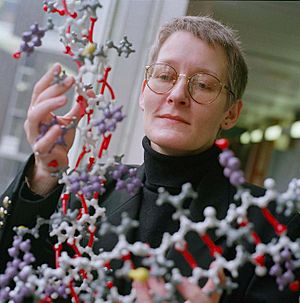Terri Attwood facts for kids
Quick facts for kids
Terri Attwood
|
|
|---|---|
 |
|
| Born |
Teresa K. Attwood
20 November 1959 |
| Alma mater | University of Leeds |
| Known for |
|
| Awards | Royal Society University Research Fellowship 1993–2002 |
| Scientific career | |
| Fields | Bioinformatics Protein fingerprinting |
| Institutions | |
| Thesis | Chromonic mesophases (1984) |
| Doctoral advisor | John E. Lydon |
| Doctoral students |
|
Teresa K. Attwood (born 20 November 1959) is a professor who studies Bioinformatics. She works at the University of Manchester in the Department of Computer Science and the School of Biological Sciences. She is also a visiting expert at the European Bioinformatics Institute (EMBL-EBI).
Professor Attwood held a special research award called a Royal Society University Research Fellowship. She had this award at University College London (UCL) from 1993 to 1999. Later, she continued her fellowship at the University of Manchester from 1999 to 2002.
Contents
What is Bioinformatics?
Bioinformatics is a cool field that mixes biology with computer science. Scientists like Professor Attwood use computers to understand huge amounts of biological information. This includes things like the building blocks of life, like DNA and proteins.
Education and Early Career
Teresa Attwood went to the University of Leeds to study science. In 1982, she earned her first degree, a Bachelor of Science, in Biophysics. Biophysics is about how physics helps us understand living things.
Just two years later, in 1984, she earned her PhD (a higher degree) in Biophysics. Her research focused on special materials called chromonic mesophases.
Postdoctoral Research
After getting her PhD, Professor Attwood continued her research at the University of Leeds. She worked there until 1993. Then, she moved to University College London for five years. In 1999, she joined the University of Manchester.
Research on Proteins
Professor Attwood's main research helps us understand proteins. Proteins are tiny machines inside our bodies that do many important jobs. She studies how to compare and analyze protein sequences. This helps scientists learn what proteins do.
Creating the PRINTS Database
Professor Attwood was inspired by another project called PROSITE. She then created her own way to identify proteins, like giving them a "fingerprint." She used this method to build a database called PRINTS. This database helps scientists find patterns in proteins.
Working on InterPro
She worked with another scientist, Amos Bairoch, to combine different ways of classifying proteins. They received a grant from the European Union. This led to the creation of InterPro in 1997. InterPro is a big project that brings together several protein databases.
Leading Big Projects
Professor Attwood has led many important projects. These include BioMinT, which uses computers to find information in text. She also worked on EMBER, which helps teach people about bioinformatics. She was also involved in projects like SeqAhead and AllBio, which deal with analyzing DNA and other biological data.
She is currently the Chair of the EMBnet Global Bioinformatics Network. This network helps share bioinformatics knowledge around the world. In 2012, she helped start GOBLET, a global group for bioinformatics learning and training.
Developing New Tools
Professor Attwood and her team have created computer tools to help scientists. These tools can line up and show protein sequences and structures. Some of these tools are Ambrosia and CINEMA.
Her group is also building software parts for useful bioinformatics programs called UTOPIA tools. They are also finding new ways to automatically add notes to data and search for information in text. This includes projects like PRECIS and METIS. The UTOPIA tools are used in the Semantic Biochemical Journal. They also help with a project with Pfizer and AstraZeneca to manage medical information.
Her research has received money from many important groups. These include the Royal Society and the European Union.
Teaching and Books
Professor Attwood teaches students at both undergraduate and postgraduate levels. She has also guided several PhD students, including Manuel Corpas.
She has co-written chapters for books and three popular textbooks about bioinformatics. These include Introduction to Bioinformatics and Bioinformatics and Molecular Evolution. She also co-authored Bioinformatics Challenges at the Interface of Biology and Computer Science: Mind the Gap.
Awards and Recognition
Professor Attwood received a special award called a Royal Society University Research Fellowship (URF). She held this important fellowship from 1993 to 2002.

